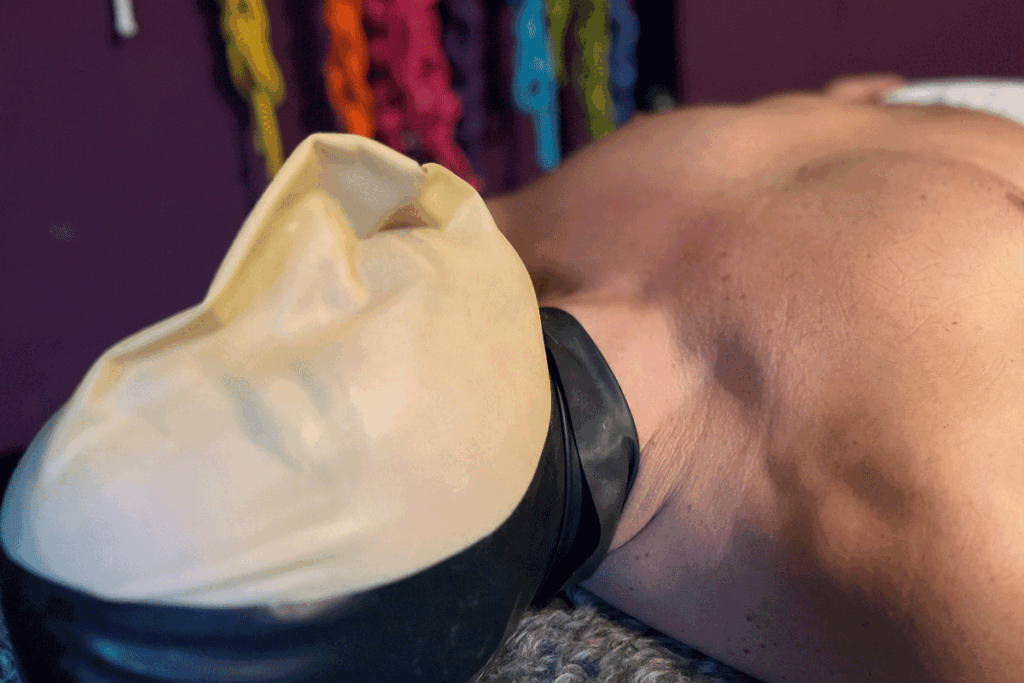Breath control
Definition
Breath reduction is a BDSM practice in which a sub’s breathing is temporarily restricted or controlled. This restriction can be physical or psychological and aims to create an increased sense of excitement, power, control, or surrender. Breath reduction is a form of edgeplay and carries both physical and mental risks.

Explanation of breath control
Breath control – also known as breath play or breath reduction – is a practice that revolves around (temporarily) restricting a person’s breathing. This can be done in various ways:
by covering the mouth and/or nose, by applying pressure to the throat, by using aids such as plastic bags or gas masks, or by maintaining a certain body posture that impedes breathing.
For many people, the excitement of breath reduction lies in the intense physical sensations and mental surrender that accompany it. The moment when you literally lose your breath and with it your control is experienced as a deep form of surrender. For the Dominant, it can be a powerful experience of total power: you determine when the other person is allowed to breathe. This intensity creates a strong bond, provided that there is complete safety, consent, and experience.
What happens in the body?
When breathing is restricted, the oxygen level in your blood drops and the amount of carbon dioxide (CO₂) rises. This leads to:
- Accelerated heart rate
- Increased blood pressure
- Lightheadedness or euphoria
- Temporary dizziness or tingling
- A feeling of dissociation or “being high”
- Increased production of adrenaline and endorphins
It is important to realize that these effects are not a game. Too little oxygen can lead to loss of consciousness within seconds and, with prolonged oxygen deprivation, even to brain damage or death. No matter how exciting the effects may be, the risks are real and irreversible.
Risks
Breath reduction is one of the most dangerous forms of BDSM play. The main risks are:
- Fainting or losing consciousness
- Brain damage due to oxygen deprivation (hypoxia)
- Cardiac arrest or cardiac arrhythmia
- Injury to the windpipe or cervical vertebrae
- Trauma or panic reactions, especially in people with anxiety or PTSD symptoms
- Unintended death due to respiratory arrest (asphyxia)
Even if the game “seems to be going well,” the effect on organs or the brain may only become apparent later. Therefore, breath play is life-threatening and never recommended.
Safety & points of attention
Breath reduction is edge play, and therefore risky by definition. If you do decide to explore this practice, there are some absolute basic conditions:
- Never do this alone
- Solo breath play is the leading cause of death in kinky solo play.
- Know the anatomy
- Never press on the center of the throat (larynx), but when playing with your hands, always press on the sides of the neck.
- Do not use plastic bags or improvised materials
- The risks are unpredictable and there is a danger of suffocation.
- Make agreements in advance
- Agree not only on a safe word, but also on a non-verbal signal (such as squeezing, tapping, or blinking).
- Observe continuously
- Any changes in pupil size, color of lips or fingers, or other reactions? Stop immediately.
- Limit the duration
- Keep each breath reduction shorter than 10 seconds💡 and give the body time to recover.
- Provide good aftercare
- After breath reduction, confusion, emotional intensity, or physical exhaustion may occur. Be there for each other.
- Be sober
- No alcohol, drugs, or medication that affects your heart rate, breathing, or consciousness.
Please note
5–10 seconds of breath holding often produces an intense physical effect (pressure, warmth, lightheadedness) without immediate danger of oxygen deprivation.
For many healthy people, 15–20 seconds is still physically manageable, provided that:
- the person is sober,
- in good health,
- does not become anxious or panicky,
- and is given sufficient time to recover immediately afterwards.
Longer than 20 seconds is medically risky, especially if there is pressure on the airways or respiratory arrest. Loss of consciousness can occur after 30 seconds – sometimes sooner in certain body positions, illnesses or stress.
Related terms breath control
Breathing restriction
Breath control
Breathplay
Carotid sinus reflex
CRT
Edgeplay
Hypoxiphilia
Strangulation sex
More information

